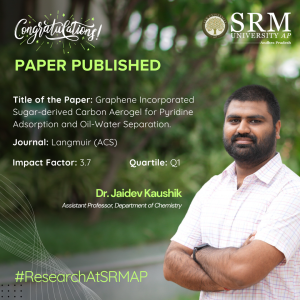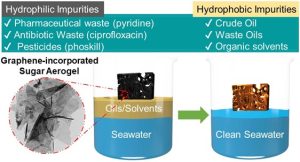 Dr Jaidev Kaushik, an Assistant Professor in the Department of Chemistry, has recently published a pioneering research paper in the prestigious journal Langmuir (ACS). The paper, titled “Graphene Incorporated Sugar-derived Carbon Aerogel for Pyridine Adsorption and Oil-Water Separation,” explores innovative applications of graphene-based materials.
Dr Jaidev Kaushik, an Assistant Professor in the Department of Chemistry, has recently published a pioneering research paper in the prestigious journal Langmuir (ACS). The paper, titled “Graphene Incorporated Sugar-derived Carbon Aerogel for Pyridine Adsorption and Oil-Water Separation,” explores innovative applications of graphene-based materials.
Dr Kaushik’s research focuses on the development of a novel carbon aerogel derived from sugar and incorporated with graphene. This material demonstrates exceptional efficiency in adsorbing pyridine, a harmful organic compound, and effectively separating oil from water. These findings hold significant promise for environmental remediation and industrial applications, offering a sustainable solution to pollution and waste management challenges.
The publication of this paper in Langmuir highlights the cutting-edge research being conducted at SRM University-AP and underscores Dr Kaushik’s contributions to the field of chemistry. His work not only advances scientific understanding but also paves the way for practical applications that can benefit society at large.
Abstract
In this report, we have synthesized three-dimensional and hydrophobic graphene-incorporated carbon aerogel (G-SCA) derived from sugar. G-SCA is being used as a multifunctional sorbent material for removing various advanced water soluble and insoluble pollutants Initially, G-SCA is being explored for the adsorption of nitrophenols, nitroaromatics (3-nitroaniline), insecticide (Phoskill), antibiotic (ciprofloxacin), and pharmaceutical drug precursor (pyridine). Later, same G-SCA is also explored in the absorption of various protic and aprotic organic solvents and oils (including crude oil, waste cooking oil, and waste Mobil oil), with excellent recyclability checked up to 10 cycles. Moreover, oil-water separation experiments are also being done in various industrial wastewater samples and seawater to support the real-life accessibility of present approach. Large-scale applicability of G-SCA is also checked by performing crude oil-seawater separation experiments using a laboratory-scale prototype demonstrating the successful continuous recovery of crude oil.
Explanation of The Research in Layperson’s Terms
This research demonstrates the synthesis of carbon aerogel from edible sugar followed by the incorporation of graphene oxide to make a near superhydrophobic and good water-floating sorbent material. Later, this sorbent material was used to decontaminate wastewater from advanced pollutants such as explosive wastes, expired antibiotics, pharmaceutical waste, insecticides, etc. This report also showed the practical demonstration of crude oil recovery from seawater, thus contributing to the circular economy process.

Title of Research Paper in the Citation Format
F. Agrawal, K. Gupta, J. Kaushik, K. M. Tripathi, S. K. Choudhary, S. K. Sonkar, Graphene Incorporated Sugar Derived Carbon Aerogel for Pyridine Adsorption and Oil–Water Separation, Langmuir 2024, 40, 18028–18038.
Practical Implementation or the Social Implications Associated with the Research
This work describes the synthesis of low-cost near superhydrophobic carbon aerogel, displaying its multiple applications in wastewater treatment from water-soluble and water-insoluble pollutants. It is also an alternative and cost-effective approach for recovering valuable oil and organic compounds from water rather than degrading or destroying them so they can be reused.
Collaborations
Dr Sumit Kumar Sonkar (MNIT Jaipur, India)
Future Research Plans
1. The adsorption/photodegradation-assisted quick and efficient removal of next generation advanced pollutants such as microplastic, pesticides, pharmaceutical waste, etc. by hydrophobic carbon aerogel and their doped and functionalised versions.
2. Utilizing waste derived heterogeneous catalysts in organic transformation reactions.
3. Selective sensing of toxic metal ions/biomarkers/biomolecules using fluorescent nanomaterials.
4. Upcycling of carbonates/CO2 via photo/thermal assisted reactions to get C1 and C2 hydrocarbons (green fuel).

